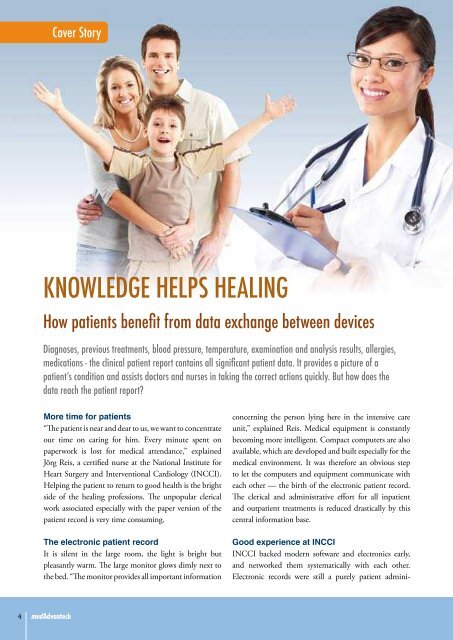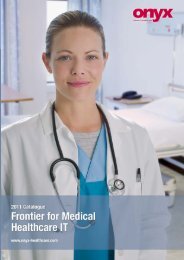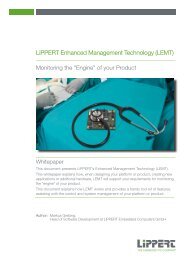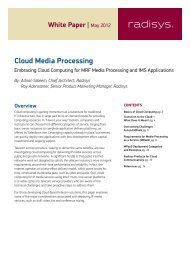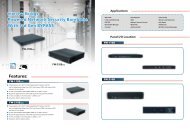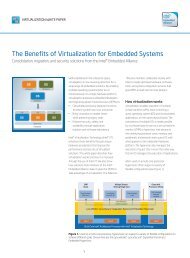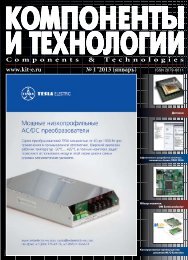Knowledge helps healing - Embedded Community - Intel
Knowledge helps healing - Embedded Community - Intel
Knowledge helps healing - Embedded Community - Intel
You also want an ePaper? Increase the reach of your titles
YUMPU automatically turns print PDFs into web optimized ePapers that Google loves.
Cover story<br />
<strong>Knowledge</strong> <strong>helps</strong> <strong>healing</strong><br />
How patients benefit from data exchange between devices<br />
diagnoses, previous treatments, blood pressure, temperature, examination and analysis results, allergies,<br />
medications - the clinical patient report contains all significant patient data. It provides a picture of a<br />
patient‘s condition and assists doctors and nurses in taking the correct actions quickly. But how does the<br />
data reach the patient report?<br />
More time for patients<br />
“The patient is near and dear to us, we want to concentrate<br />
our time on caring for him. Every minute spent on<br />
paperwork is lost for medical attendance,” explained<br />
Jörg Reis, a certified nurse at the National Institute for<br />
Heart Surgery and Interventional Cardiology (INCCI).<br />
Helping the patient to return to good health is the bright<br />
side of the <strong>healing</strong> professions. The unpopular clerical<br />
work associated especially with the paper version of the<br />
patient record is very time consuming.<br />
The electronic patient record<br />
It is silent in the large room, the light is bright but<br />
pleasantly warm. The large monitor glows dimly next to<br />
the bed. “The monitor provides all important information<br />
concerning the person lying here in the intensive care<br />
unit,” explained Reis. Medical equipment is constantly<br />
becoming more intelligent. Compact computers are also<br />
available, which are developed and built especially for the<br />
medical environment. It was therefore an obvious step<br />
to let the computers and equipment communicate with<br />
each other — the birth of the electronic patient record.<br />
The clerical and administrative effort for all inpatient<br />
and outpatient treatments is reduced drastically by this<br />
central information base.<br />
Good experience at INCCI<br />
INCCI backed modern software and electronics early,<br />
and networked them systematically with each other.<br />
Electronic records were still a purely patient admini-<br />
stration tool back in 2001. By 2009, clinical records had<br />
reached the operating theater, the wards and finally the<br />
catheter laboratory. The cardiological image archiving<br />
and communications system was added in 2010. In<br />
the meantime, all hospitals in Luxemburg and their<br />
cardiologists have access to the digital patient archive. The<br />
archive complies with the strict directives of the European<br />
data protection act. Access rights protect sensitive data,<br />
restricting delivery to authorized caregivers. “Our team<br />
has accepted the new technology very well. The terminals<br />
are now a valuable element of our everyday nursing,” says<br />
Reis.<br />
All information in the right place<br />
The benefit for the patient is great, because data is available<br />
exactly at the point where it is needed, thanks to the<br />
electronic patient record. The information accompanies<br />
the patients from the operating theater to the ward bed.<br />
“All of our intensive care beds have a dedicated terminal,<br />
from which the patient’s data can be called up. This<br />
ensures the greatest possible security for the patient,”<br />
explained Reis. The computer logs the procedures of<br />
the cardiopulmonary bypass or other intensive medical<br />
equipment, just like an efficient secretary, and converts<br />
the multitude of numbers into illustrative curves.<br />
Interrelationships can then be identified at a glance.<br />
Male nurse Ludovic Loret<br />
at INCCI intensive care<br />
This simplifies making correct decisions. “The more<br />
information available, the better help can be given. It<br />
happens faster and is more reliable than the old paper<br />
record,” explained Reis.<br />
The technology<br />
The monitors with embedded computers, so-called<br />
point-of-care terminals are built specifically for the<br />
medical environment. Their surfaces can easily be<br />
Jörg Reis is a certified male nurse and IT specialist for<br />
application development. He works for INCCI, the<br />
National Institute for Heart Surgery and Interventional<br />
Cardiology in Luxemburg, and ensures that technology<br />
and software related to the electronic patient record<br />
functions smoothly.<br />
National Institute for Heart Surgery<br />
and Interventional Cardiology INCCI<br />
Three surgeons, eleven cardiologists, four anesthesia<br />
specialists, and intensive care work go on at INCCI.<br />
A total of 90 people provide 24-hour full medical<br />
care. The heart surgery department has two operating<br />
theaters, four intensive care beds, four middle care<br />
beds and seven beds for normal medical care. Two<br />
theaters are available in the interventional cardiology<br />
department for heart catheter examinations. Since its<br />
opening in June 2001, the department for anesthesia<br />
and intensive care has treated more than 500 heart<br />
patients.<br />
kept sterile. The devices are quiet and clean, since they<br />
function without ventilation fans. As a result, they are<br />
also used in the operating theater to assist the anesthetist.<br />
The terminals operate 24 hours per day and are replaced<br />
by the next generation after approximately four years.<br />
INCCI has just installed the new generation point-ofcare<br />
terminals (POC) from Advantech. “We decided to<br />
buy the Advantech POC, because the technology, price<br />
and support are right for us. I can buy the equipment<br />
with or without touchscreen, with professional support<br />
at my side, offered by Advantech’s integration partner<br />
Megabyte Systemhaus, who I can rely on to give me good<br />
support,” commented Reis.<br />
1 st 4 1 issue 2011 5<br />
st issue 2011


